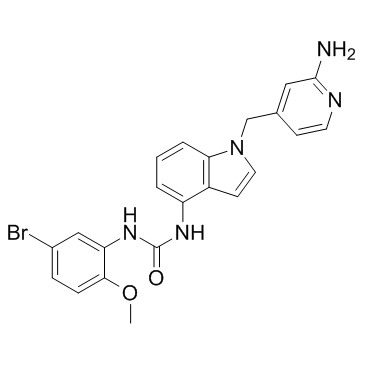| Description |
JI-101 is an orally available multi-kinase inhibitor of VEGFR2,PDGFRβ and EphB4 with potent anti-cancer activity.
|
| Related Catalog |
|
| Target |
VEGFR2
PDGFRβ
|
| In Vitro |
JI-101 is found to be stable in all preclinical and human liver microsomes. The % metabolized is ranged between 3.03-3.95 across the tested species liver microsomes. The % metabolized is relatively higher in mice liver microsomes followed by dog, human and rat liver microsomes[1].
|
| In Vivo |
JI-101excreted through bile along with its mono- and di-hydroxy metabolites. Following oral administration, JI-101 is rapidly absorbed, reaching Cmax within 2 h. The t1/2 of JI-101 with intravenous and oral route is found to be 1.75±0.79 and 2.66±0.13 h, respectively. The Cl and Vd by intravenous route for JI-101 are found to be 13.0±2.62 mL/min/kg and 2.11±1.42 L/kg, respectively. The tissue distribution of JI-101 is extensive with rapid and preferred uptake into lung tissue. Overall, the oral bioavailability of JI-101 is 55% and the primary route of elimination for JI-101 is feces[1].
|
| Animal Admin |
Rats: Pharmacokinetics and bioavailability assessment of JI-101 are evaluated in a preliminary parallel-group study in male S.D. rats. Four rats (195–210 g) per route receive JI-101 at a dose of 3 and 30 mg/kg for i. v. (via tail vein) and oral dose (by gavage), respectively. Serial blood samples (100 μL) are collected from retro-orbital plexus at pre-dose, 0.12 ( i. v. only) 0.25, 0.5, 1, 2, 4, 8, 10 (oral only) and 24 h. Blood samples are collected in tubes containing K2 EDTA as the anticoagulant and centrifuged for 5 min maintained at 4 °C for plasma separation and stored frozen at −80±10 °C until analysis[1].
|
| References |
[1]. Gurav SD, et al. Pharmacokinetics, tissue distribution and identification of putative metabolites of JI-101 - a novel triple kinase inhibitor in rats. Arzneimittelforschung. 2012 Jan;62(1):27-34.
|
